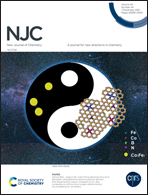Multi-stimuli responsive properties and structure–property studies of tetraphenylethylene functionalized arylimidazole derivatives†
Abstract
Tetraphenylethylene functionalized arylimidazole derivatives G4, G3, G2, L-G4, L-G3 and L-G2 with different substituent groups and geometric structures have been designed and synthesized. All the compounds exhibited excellent aggregation-induced emission (AIE) properties due to the restricted intramolecular rotation (RIR) and the formation of J-aggregates. The solid compounds showed highly efficient emission with fluorescence quantum yields (ΦPL) of 67%, 72%, 67%, 40%, 52% and 48% for G4, G3, G2, L-G4, L-G3, and L-G2, respectively. The structure–property studies revealed that G4, G3 and G2 were more twisted structures and L-G4, L-G3 and L-G2 were partially planar conformations. The high quantum yields of the six solid compounds were driven by the synergistic effects of intramolecular electron transfer, molecular configuration and intermolecular interactions. On the other hand, the compounds also showed mechanochromism, acidochromism and picric acid-sensing properties. The compounds presented reversible mechanochromic behaviors between green and yellow emission and maintained highly solid emission (ΦPL about 50%) after grinding. The ΦPL values of the twisted molecules of G4, G3, and G2 decreased about 20% and those of the planar compounds showed a negligible change, which could be explained by the molecular structure planarization and the increased intermolecular interactions after grinding. Meanwhile, due to the excellent proton-binding properties of the imidazole group and pyridine group, the compounds were used as picric acid (PA) sensors with high selectivity and sensitivity in aqueous media and acid/base switches. The relative mechanism was ascribed to the photo-induced electron transfer (PET) and protonation, which were verified by 1H NMR spectra and theoretical calculations.



 Please wait while we load your content...
Please wait while we load your content...